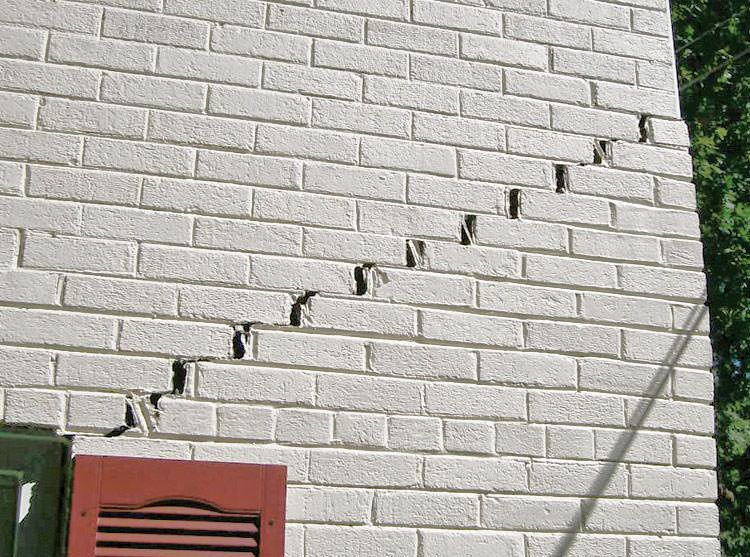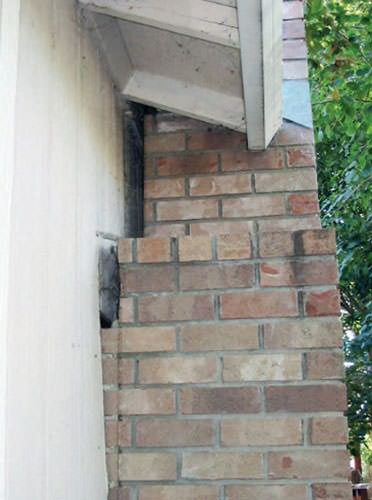Sinking & Settling Foundation Repair Near Evansville, Owensboro, Newburgh
Solving structural problems due to foundation settlement

There are usually a number of different soil layers underneath a house.
Foundation settlement and house movement can occur when one of these soil layers can't support the weight of the home.
The Problem:
Your home is showing signs of damage related to foundation settlement.
Telltale Signs:
- Stair-step cracks in brick or concrete block foundation walls
- Leaning, tilting chimneys
- Cracks around doors and windows
- Jamming, sticking doors and windows
- Cracks in a concrete slab floor
- Cracks in drywall
How to Fix It:
We fix foundation settlement issues by installing steel foundation piers. These piers will extend beneath the foundation, contacting strong supporting soils that will permanently stabilize your structure.
At Healthy Spaces, we solve foundation settlement issues of all kinds! Call us for a free foundation settlement repair quote today!
We serve Newburgh, Owensboro, Evansville, and many nearby areas in Indiana and Kentucky.
Identifying Foundation Settlement Issues
Signs of a settling foundation can be very subtle at first -- many homeowners can go months or even years before noticing a crack in their foundation. The long-term damage from foundation settlement, however, is ongoing and will lead to more severe foundation problems.
Repairing Foundation Settlement
At Healthy Spaces, we recommend installing foundation piers to stabilize, repair, and restore a foundation that's been damaged by issues related to foundation settlement and poor supporting soils.
There are several different types of foundation piers; each one is designed to address a different kind of foundation problem. We install three different kinds of foundation piers: push piers, helical piers, and slab piers.
Foundation Push Piers

Push piers connect the foundation to strong, stable soil or bedrock.
Foundation piers attach to the base of the foundation with special brackets and extend through settling and unstable soil layers, transferring the weight of your home to competent soils or bedrock.
Foundation push piers are straight, steel piers that attach to your foundation and extend far below the structure to strong supporting soils.
During the installation, a section of the foundation footing is exposed and cut to attach to each pier's bracket. This is possible year-round from either inside or outside of your foundation or structure.
Foundation brackets are secured to the footing, and tubular pier sections are hydraulically driven through each bracket.
Pier sections continue to be driven downwards until the piers meet competent strata that can bear the weight of your home without compression.
When all push piers have been installed, they will work in unison to transfer the weight of the structure to the strong soils or bedrock below. If possible, the home is also lifted back to its original, level position.
More about installing foundation push piers.
Read about our push pier system.
Foundation Helical Piers

Illustration of foundation helical piers stabilizing a home.
Like push piers, helical piers are attached to the foundation by mounting a bracket. Helical piers include rotating blades that are advanced (or "screwed") into the soil.
Foundation helical piers are straight, steel piers that have helical blades welded to each shaft. This installation is possible from either inside or outside of your foundation.
These piers are driven into the soils underneath your foundation, then each pier is connected to the structure's foundation via a steel bracket.
During the installation, a section of the footing is exposed and cut for each bracket.
Next, round-shaft helical piers are mechanically advanced into the soil.
Once the helical pier has been advanced into the soil, a foundation bracket is secured to the footing.
When all helical piers have been installed, they will work in unison to transfer the weight of the structure to competent soil. If possible, the structure is also lifted back to a level position.
More about installing foundation helical piers.
Read about our helical pier system.
Slab Pier Systems

Slab piers can stabilize a settling concrete slab.
When the soil beneath a concrete slab shrinks or settles, the slab itself is also likely to settle, often cracking in the process. Slab piers restore stability by connecting the slab to competent soil at greater depth.
Slab piers are not appropriate for supporting foundation walls or repairing damage caused by foundation heave.
Foundation slab piers are straight steel piers that extend from stable soils deep below the structure to support brackets directly in contact with the underside of the slab.
These piers are meant to support a settling concrete floor, and are not appropriate for foundation wall stabilization.
Slab piers are also inappropriate for repairing heaving foundations, where the floor is being lifted by expansive soils or frost heave.
During installation, a small hole is cored through the concrete floor. A slab bracket is assembled beneath the concrete slab, and steel tubes are hydraulically driven down through this bracket assembly.
When the slab piers have reached competent soils, the weight of the slab is transferred through the piers to load-bearing soils below. If possible, the slab is lifted back to level position.
At the end of the installation, grout is pumped under the slab to fill any voids, and all cored holes in the slab are restored with new concrete for a clean, professional look.
This installation is possible year-round, and provides a permanent solution for your home.
More about slab floor cracks and uneven floors.
Read about our slab pier system.
What NOT To Do
Like all home improvements and repairs, some methods work better than others. On the other hand, some methods seem to hardly work at all. In fact, at Healthy Spaces, we find that many of our foundation repair jobs are actually just fixing the unsuccessful repairs of other contractors.
Based on our experiences throughout Indiana and Kentucky, here are three "fixes" that we do NOT recommend:

A complete foundation replacement in Petersburg. The house is placed on temporary supports while the foundation is excavated and replaced.
Total Foundation Replacement
To completely replace your home's foundation, the soil will have to be removed from around your home and your home will be jacked up and placed on temporary supports.
Next, your foundation walls are completely removed, and a new set of walls are constructed.
This is expensive, time-consuming, and extremely disruptive for a family. Even worse, it doesn't even address the real problem -- the soils around your foundation.
Many homeowners remove and replace their foundation without addressing the problem that caused the foundation issue in the first place. When this happens, they often find that after several years, they're facing the same problem all over again.
At Healthy Spaces, we address the problem with warrantied solutions that will fix your problem once and for all.

Concrete underpinning failed to stabilize this house. Eventually, the homeowner had to invest in a different, more permanent solution for their home.
Concrete Underpinning
To install concrete underpinning, the soils must be excavated from around the foundation. Larger concrete footings are poured beneath the existing footings. Once the concrete has cured, the soil is backfilled.
When it comes to foundation footings, "bigger" is not necessarily "better." Most of the time, the underpinning will not extend beyond the problem soils under your home. If this is true, the larger footings you just paid for will continue to move and cause damage.
Concrete shrinks as it cures, and small gaps can form between the new and old footings. Open gaps beneath a home are never a good thing!
When concrete underpinning is installed and fails to solve the problem, it is much more expensive to repair. Before installing a new foundation system, all that added concrete will need to be removed.

Concrete piers are too big and blunt to be driven deep into foundation soils, so they usually don't extend to competent supporting soils.
These piers can crack under pressure, and they often install unevenly or crookedly under your home.
Concrete Piers
To install concrete piers under a home, the soil will first need to be excavated from around your foundation.
Short, 6"-8" wide concrete cylinders are then pushed into the soil on top of one another, strung together by a wire. Shims are then placed between the top of the concrete pier and the footing, then the soil is backfilled. The over-lifting process required to perform shimming may lead to further damage to your foundation.
Blunt, wide concrete cylinders are difficult to push deep into the ground, making it very difficult to extend them past the poor supporting soils under your home.
Concrete can crack and break when under pressure, and even in response to temperature changes, making concrete piers a flimsy repair method.
Additionally, there is nothing to guide the direction for the pier, which means they might not be installed straight. So how will they support your home?
Because of these and other reasons, very few companies will recommend this kind of approach.
We Repair Settling Foundations in IN and KY!
At Healthy Spaces, we can identify and repair any issue you may be having with settling, sinking foundations, and settlement house movement. We have a wide variety of solutions for foundation repair that have been tested and proven effective throughout the United States and Canada through the Foundation Supportworks network of foundation contractors.
Each of our solutions starts with a free, written foundation repair quote, and includes a personal consultation with a foundation expert, an in-person inspection, and a free copy of our 90-page foundation repair book. To schedule an appointment with one of our specialists, call or e-mail us today!
We proudly serve Owensboro, Evansville, Newburgh, areas such as Madisonville, Vincennes, Henderson, Haubstadt, Washington, Sheperdsville, Jasper, and nearby.
Looking for a price? Get a no cost, no obligation free estimate.
our service area
We serve the following areas
- Baskett
- Burna
- Clay
- Corydon
- Crayne
- Dawson Springs
- Dixon
- Dycusburg
- Earlington
- Fredonia
- Hampton
- Hanson
- Henderson
- Madisonville
- Manitou
- Marion
- Morganfield
- Nebo
- Nortonville
- Poole
- Providence
- Robards
- Saint Charles
- Salem
- Sebree
- Slaughters
- Smith Mills
- Smithland
- Sturgis
- Sullivan
- Tiline
- Uniontown
- Waverly
- Wheatcroft
- Cynthiana
- Decker
- Evansville
- Fort Branch
- Francisco
- Griffin
- Haubstadt
- Hazleton
- Mount Vernon
- New Harmony
- Owensville
- Patoka
- Poseyville
- Princeton
- Vincennes
- Wadesville











